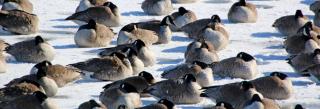
The Sandman Goes Wild
Sleep.
For humans, sleeping involves closing their eyes and drifting away into a state of rest for the mind and body. In the safety and warmth of their home, this is typically accomplished in about eight hours. For teenagers, sometimes it takes much longer.
All living creatures, from the smallest to the largest, must obtain some form of rest in their daily cycle, but how much?
Bats top the sleeping charts – albeit, upside down – by collecting about 20 hours a day. Squirrels always appear on the go gathering food, climbing trees, and boldly racing from limb to limb many feet off the ground. Even so, bushytails still manage to work in an enviable 15 hours of sleep. These small North Dakota mammals get ample sleep compared to only four hours for African elephants and two for the sleep deprived giraffe. In general, small animals require more sleep than large animals, probably because it helps them to conserve energy.
Whether fish sleep is a mystery since they never close their eyes. They do slow down for periods, scientists say, but it’s debated if you can call that sleep.
Predators typically get more shuteye than prey. Deer, for example, only get about one hour of good sleep as a defense to predators that want to eat them, said Bill Jensen, North Dakota Game and Fish Department big game biologist.
Some animals, researchers say, can sleep and be awake at the same time.
Have you ever tried to sneak up on a handful of mallards taking a snooze in a wetland? They appear passive, with bills tucked into shoulder feathers, dreaming about sago ponds surrounded by grasslands. You Approach silently, but they know you’re there, retreating quickly into the sky when you get too close.
Birds pull this off because they’re able to sleep with one eye open. It’s called unihemispheric sleep, where one side of the brain sleeps while the other remains alert to predators. Mallards stationed at the outer ends of the group are more often in a unihemispheric state, keeping the eye that faces away from the group open to danger. To make sure both brain hemispheres receive needed rest, the birds will occasionally rotate their bodies, then close the tired eye and open the rested.
Sleep deprived deer everywhere, of course, are going to be jealous once they learn of this.
